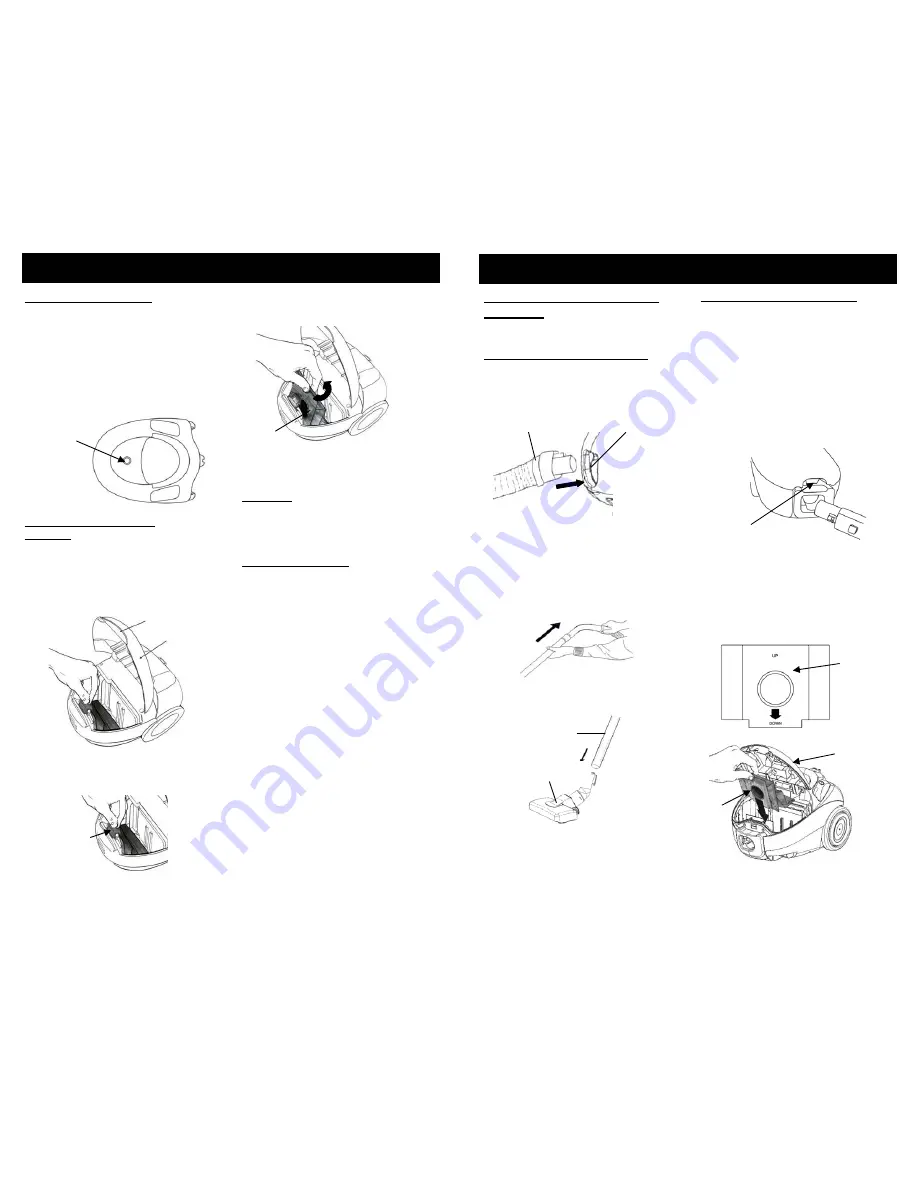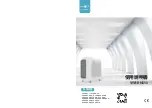
Indentation
d’ouverture
Fig. 4
OPERATING INSTRUCTIONS
Dust Bag Full Indicator
The red dust bag full indicator may turn
on while you are cleaning to indicate
that the cloth/paper dust bag is full and
requires emptying or replacement.
(Fig 14)
Note:
You can test the dust bag full
indicator by placing your hand over the
end of the flexible hose when the
vacuum is running. The dust bag full
indicator should turn red.
7
Replacing the Dust Bag
Warning
: To reduce the risk of electric
shock, the power cord must be
disconnected before changing the dust
bag or performing maintenance/trouble
shooting checks.
1. To open main unit, pull up on the
opening indentation. (Fig. 15)
Opening
Indentation
Top Cover
Fig. 15
4. Replace with a new clean dust bag
and ensure the bags cardboard collar
is locked in place with the bag lock.
Warning
:
Before closing main unit,
make certain that paper bag or cloth bag
is well inside the compartment and does
not get caught between the hinges when
closing the cover.
Fig. 17
Bag
Lock
Dust Bag
3. Then pull up on the cardboard collar
and gently lift the bag out of the
compartment. (Fig. 17)
Dust Bag
Full
Indicator
Fig. 14
Fig. 16
Cleaning the Filters
Your vacuum is equipped with a filtration
system, which helps to reduce dust and
pollen in your home. The pre-motor filter
prevents dust from entering the motor
chamber, while the post-motor filter helps
to clean the vacuum’s exhaust.
Both the pre-motor and post-motor filters
may be hand-washed and reused as
needed. To do so, rinse the filters under
lukewarm water until the water runs
clear. Always allow the filters to air dry
for a minimum of 24 hours.
Note
:
The pre-motor and post-motor
filters should be removed, cleaned and
re-inserted at least twice a year.
Caution
: DO NOT
operate your vacuum
without both filters in place.
Caution
: DO NOT
operate your vacuum
with a wet or damp filter in place.
2. Remove the old dust bag by pressing
the bag lock towards you and away
from the bag. (Fig. 16)
Brosse à plancher
et tapis
Extension
du tuyau
INSTRUCTIONS D’UTILISATION
Assemblage de votre aspirateur
Remarque:
Retirez toujours la fiche
d’alimentation de la prise murale avant
d’assembler ou de retirer les accessoires.
24
Attachement du tuyau flexible
1. Insérez le tuyau flexible dans la
conduite d’entrée d’air. Poussez
jusqu’à ce que vous entendiez un
déclic indiçant que le tuyau flexible
est en place. (Fig. 1)
Insertion du sac à poussière
Avertissement:
Afin de réduire les
risques de décharges électriques, le
cordon d’alimentation doit être
déconnecté avant d’effectuer le
changement du sac de poussière ou tout
type d'entretien ou de résolution de
problème.
1. Enlevez le tuyau flexible dans la
conduite d’entrée d’air par appuyez
sur le bouton de dégagement du tuyau
et tirez dessus. Placez vos doigts
dans l’indentation d'ouverture et
soulevez le couvercle. (Fig. 4)
3. Poussez l’extension du tuyau inférieur
dans la brosse à plancher et tapis.
(Fig. 3)
Fig. 2
Fig. 3
2. Insérez le tuyau d’extension
supérieur dans le tube
courbé/extension de tuyau.
L’extension de tuyau supérieur est
celle qui est attachée au chariot
d’accessoires. Ensuite, insérez
l’extension de tuyau inférieur dans
l’extension du tube supérieur.
(Fig. 2)
Fig. 1
Conduite d’entrée
Tuyau flexible
Fig. 6
Couvercle
Sac à
poussière
3. Placez le sac à poussière à l’intérieur
de l’unité principale et guidez le collet
de carton dans la fiche.
Fig. 5
Collet en carton
2. En tenant le sac à poussière dans
votre main, attrapez le collet en
carton. (Fig. 5). Vous remarquerez
que le collet en carton possède
une flèche qui montre quelle
extrémité doit être insérée dans la
fiche située près de la conduite
d’entrée. (Fig. 6)


































